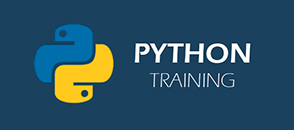Enroll Now

 Online Training
Online Training
 Corporate Training
Corporate Training
 Classroom
Classroom
Python Training
United Global Soft Python online course designed to give you a basic and advanced familiarity with the
concepts of Python programming language.
Course Overview
Python has been one of the premier, flexible, and powerful open-source language that is easy to learn,
easy to use, and has powerful libraries for data manipulation and analysis. For over a
decade,Python has been used in scientific computing and highly quantitative domains such as finance,
oil and gas, physics, and signal processing. This course will cover both basic and advance concepts
ofPython like writing python scripts, sequence and file operations in python, Machine Learning
in Python, Web Scraping, Map Reduce in Python, Hadoop Streaming, Python UDF for Pig and Hive. You
will also go through important and most widely used packages like pydoop, pandas, scikit, numpy
scipy etc.s
Who should go for this course?:
Experienced Professional or a Beginner, Anyone who wants to learn programming with Python can
start right away!
This course is exclusively designed for professionals aspiring to make a career in Big Data Analytics
using Python. Software Professionals, Analytics Professionals, ETL developers, Project Managers,
Testing Professionals are the key beneficiaries of this course. Other professionals who are looking
forward to acquire a solid foundation of this widely-used open source general-purpose scripting
language, can also opt for this course.
Pre-requisites:
Although there are no hard pre-requisites, attendees having prior programming experience and
familiarity with basic concepts such as variables/scopes, flow-control, and functions would be
beneficial. Prior exposure to object-oriented programming concepts is not required, but definitely
beneficial.
Why learn Python?
Programmers love Python because of how fast and easy it is to use. Python cuts development time in
half with its simple to read syntax and easy compilation feature. Debugging your programs is a breeze
in Python with its built in debugger. Using Python makes Programmers more productive and their
programs ultimately better. Python is continued to be a favourite option for data scientists who use it
for building and using Machine learning applications and other scientific computations.
Python runs on Windows, Linux/Unix, Mac OS and has been ported to Java and .NET virtual
machines. Python is free to use, even for the commercial products, because of its OSI-approved open
source license.
Python has evolved as the most preferred Language for Data Analytics and the increasing search
trends on python also indicates that Python is the next "Big Thing" and a must for Professionals in the
Data Analytics domain.
Python Course Outline
An Overview of Python
- What is Python?
- Interpreted languages
- Advantages and disadvantages
- Downloading and installing
- Which version of Python
- Where to find documentation
The python environment
- Structure of a Python script
- Using the interpreter interactivel
- Running standalone scripts under Unix and Windows
Getting Started
- Using variables
- String types: normal, raw and Unicode
- String operators and expressions
- Math operators and expressions
- Writing to the screen
- Command line parameters
- Reading from the keyboard
Flow Control
- About flow control
- Indenting is significant
- The if and elif statements
- while loops
- Using lists
- Using the for statement
- The range() function
Array types
- list operations
- list methods
- Strings are special kinds of lists
- tuples
- sets
- Dictionaries
Working with Files
- Text file I/O overview
- Opening a text file
- Reading text files
- Raw (binary) data
- Using the pickle module
- Writing to a text file
Dictionaries and Sets
- Dictionary overview
- Creating dictionaries
- Dictionary functions
- Fetching keys or values
- Testing for existence of elements
- Deleting elements
Functions
- Syntax of function definition
- Formal parameters
- Global versus local variables
- Passing parameters and returning values
Sorting
- The sorted() function
- Alternate keys
- Multiple keys
- Lambda functions
Errors and Exception Handling
- Dealing with syntax errors
- Exceptions
- Handling exceptions with try/except
- Cleaning up with finally
Modules and Packages
- What is a module?
- The import statement
- Function aliases
- Packages
Regular Expressions
- RE Objects
- Pattern matching
- Parsing data
- Subexpressions
- Complex substitutions
- RE tips and tricks
Highlights of the Standard Library
- Working with the operating system
- Grabbing web pages
- Sending email
- Using glob for filename wildcards
- math and random
- Accessing dates and times with datetime
- Working with compressed files
An Introduction to Python Classes
- About o-o programming
- Defining classes
- Constructors
- Instance methods
- Instance data
- Class methods and data
- Destructors
Advanced Python
MODULE 1
- Command Line arguments
- Display Hooks
- Standard data streams and Redirections
- OS module
- Sub-process module
- Forking processes
- Exec functions
- Working with comprehensions
- Working with Descriptors, Iterators, Generators and Decorators
- The yield statement
- range and x-range
- Working with Context Managers
- Wrapping Objects
- Callback functions
- Duck Typing, Monkey Patching in Python
- Encapsulating Object Creation: Factory
MODULE 2
- Introduction to Threads in python
- thread module
- threading module
- Introduction to Pipes in python
- anonymous pipes
- named pipes, fifos
- Introduction to Recursion
- Recursive functions in Python
- Depth of Recursion
MODULE 3
- CGI Programming
- Introduction to WSGI
- Introduction to PEP3333
- Bottle Framework
- Flask Framework
- WebTest Framework
- Create a basic Web Service in python
- Working with Databases
- Connecting with Cassandra DB, SQLite3, MySQL
- Database Operations
MODULE 4
- Network Programming
- Working with XML Files
- Developing GUIs
- Working with SMTP
- Integrating Python with other Languages
- Conclusion



![]() Online Training
Online Training![]() Corporate Training
Corporate Training![]() Classroom
Classroom